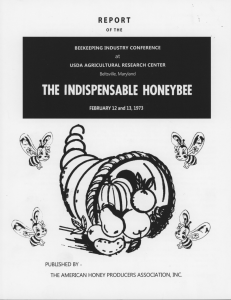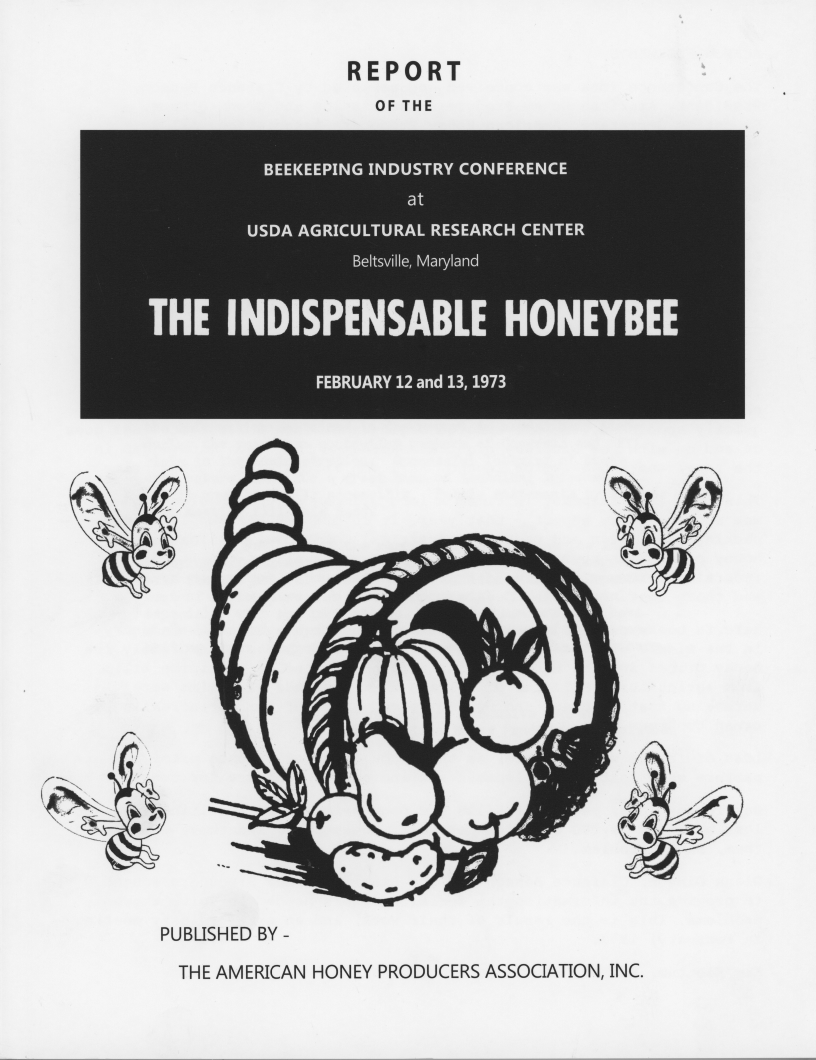1973 vs. 2015: The Financial Situation
by G. Splevin
In previous issues of Bee Culture magazine I have written of the 1973 report, “The Indispensable Honey Bee.” 
Then, as now, beekeepers’ costs comprise bees, beekeeping supplies and equipment, transportation, honey house, and labor. Land is a small cost. Inputs for beekeepers continue to be pollination fees, honey, and beeswax. In the 1973 report “All of the cost figures we examined placed a major emphasis on the costs of hives and accessories, with transportation equipment as the second most costly item purchased.”1 In 1973 the Farmers Home Administration stated per colony investments of $40. To secure a loan they would review “four basic areas of concern:”
- The soundness of the proposed operation.
- The volume of business.
- The degree of management skill and experience of the applicant.
- The possibility of his making adjustments in farming enterprise in the event the market and price conditions necessitate such adjustments.”2
The Assistant Administrator of the Farmer Program in 1973 predicted the “beekeeper’s financial position should be in a reasonably favorable climate provided: current prices are maintained; proper pesticide control is established; we have increased emphasis on marketing; new managers are encouraged to become apiculturists and you have favorable weather.” PG 46
Pollination services were valued at $1B in 1973; today pollination services are valued close to $30B. Today’s business model in beekeeping is 75% reliant upon the revenue from pollination services, with honey, wax and sales of bees comprising the balance. It is difficult to make honey even when pollinating a crop if your honey bees are killed due to pesticide exposure in the very crop being pollinated. My neighboring farmers know about my bees, and work with me to protect them from the agricultural chemicals they apply. Not all of my fellow beekeepers experience the same cooperation. Agricultural chemicals applied during bloom wreak havoc upon their honey bees. This past Fall too many friends had beeyards full of honey, and just a handful of bees in the hive. Pollinating a number of crops across the Summer those hives came home filled with a mix of chemical residues which slowly killed the hive. The Varroa counts were low because there were so few bees in the hive. Even relative to the number of bees, there were no mites because there was no brood. Certainly costs change with inflation across 43 years, but costs cannot rise enough to make up for 60% losses of bee hives in a year. I have run my small farm, sometimes “robbing Peter to pay Paul,” but I have never had Peter beaten to a pulp, and then told him to get up and go rob Paul anyway, and then get a beating from Paul!” This is the experience of my fellow beekeepers today as they try to make a living, and keep their bees healthy.
Returning to the topic of the costs of beekeeping in 1973 compared to 2016; my daughter found this easy website to calculate the value of a dollar then and now. The dollartimes.com website (http://www.dollartimes.com/inflation/inflation.php?amount=1&year=1932). According to this calculator spending $1.00 in 1973 costs $5.56 today. Beekeeping however, has not adjusted its pricing for services to inflation. The expenses for beekeeping reflect real costs, that 4.07% annual inflation, but income has not. Indemnity programs and insurance provide a cushion, at one-third to half the actual cost, but it cannot provide enough funding to rebuild a business every year. A beekeeper who loses 60% or more of their honey bees, their honey crop (dead bees do not make honey), and land on which bees can forage to make honey would not qualify as a “sound business.” Examining the Farmers Home Administration guidelines for providing a loan to a beekeeper in 1973, the bank would be hard-pressed to provide funds today.
“The soundness of the proposed operation.” I do not know of any business plan that finds a 60% or higher loss of inventory annually to represent “soundness of the proposed operation.” Certainly, the income side of a beekeeper’s business plan will look sound. However, when you apply 10-20% losses of honey bees with each crop pollinated, and 10-20% loss of honey produced due to the loss of bees, and the additional travel cost and down time if bees are taken to a native, pesticide-free area to recover (if that area can be found), beekeeping is not a sound operation from a banker’s perspective.
“The volume of business.” A number of articles have been written in recent years explaining the need for migratory beekeeping to pollinate within our monoculture. A beekeeper can be quite busy pollinating nuts, fruits, and row crops from February to August. The question is will that beekeeper have enough honey bees remaining by July and August to provide pollination services?
“The degree of management skill and experience of the applicant.” Beekeepers today have not just depth of experience, but the opportunities from honey bee research, educational programs at the local, state, and national level, as well as access to the experience and knowledge from beekeepers around the world. The management skill and experience which is difficult to explain to a loan officer is “beekeeper math.” If I have 100 hives for pollination services for one year how do I keep those hives healthy and productive?
100 hives (two deeps, 10 frame, four to a pallet) available for pollination hives pollinate almonds
-8 hives lost to pesticide exposure from neighboring field to almond orchard
-2 hives lost to Varroa
90 hives travel to apples
-6 hives lost to weather and pesticide exposure
84 hives remaining
+16 splits are made from among the 84 hives
100 hives travel to cranberries
-30 hives lost due to fungicide applications on the crop
70 hives travel to pasture land for four weeks
+20 splits made from among the 70 hives
90 hives travel to pollinate row crops in the south staying for the balance of the Summer
-54 hives lost while pollinating row crops
36 hives remain to go into Winter
I began with 100 colonies, I ended the season with 36 colonies. I suffered an overall 65% loss of honey bees. While I can make splits from strong hives early in the season, I still lost a total of 100 hives. It is only through the “degree of management skill and experience” of a beekeeper that we make the business model work. But on paper, it should not work. Beekeepers make it work by renting other beekeepers’ hives, by splitting hives that possibly are not ready to be split. The combinations of reduced bee pasture, the soup of agricultural, garden, and lawn chemicals, the effects of Varroa, and bee diseases even tax the beekeeper’s skill and experience.
“The possibility of his making adjustments in farming enterprise in the event the market and price conditions necessitate such adjustments.” Sixty-five percent losses have not been sustainable for nearly a decade. In order for “beekeeper math” to correlate with banker math, beekeeper’s need to work in 2016 dollars, not 1973 dollars. If the cost of pollination increases, it is due to the loss of native bees providing “free” pollination. The costs of monoculture only offering a food source while the one crop is in bloom also adds costs. A provided service has costs. If part of that cost is loss of workforce, then the recipient of the service needs to pay for the loss. Pollination for apples in 1973 was $10 per hive, adjusted with inflation, that cost should be $60 per hive. This does not include losses while providing the pollination service. If a beekeeper averages 65% losses annually should beekeepers be adding that to their fees? Adding a 65% loss fee to a $60 pollination fee would increase that pollination fee $39 for a total pollination fee (which would cover losses of honey bees) of $99 per hive.
The costs of beekeeping are many, and the math is not simple. The financial situation in 1973 and today though has not changed. We continue to battle the same issues in 1973 as we do today, 43 years later. Where will we be in 2059, forty-three years from now?
I hope this “curious guy” is inspiring contemplation and discussion, as beekeepers lead our state beekeeping associations, and national beekeeping organizations to willingly take simple and effective action for our bees and our industry.
1“The Indispensable Honey Bee,” published by The American Honey Producers Association, Inc. 1973; page 43, (re-print available from Bee Culture)
2Ibid, page 45
“The Indispensable Honeybee, A Report of the Beekeeping Industry Conference at USDA Agricultural Research Center, Beltsville, Maryland, Feb. 12-13, 1973” is available from Bee Culture magazine.









